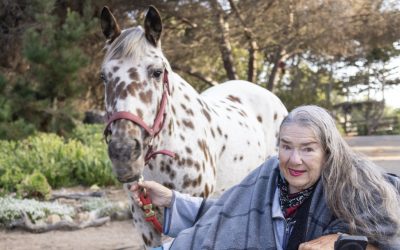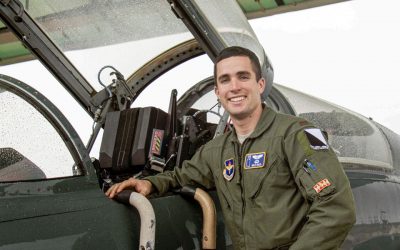When a rider-less motorcycle plowed through the window of The Anderson Hotel Barber-shop in 1963, the only damage was to the window that held its famous sign. The replacement was crafted in a hurry and lacked the word “hotel,” an omission that current owner Ray Shearer is quick to correct. To him, the shop is still The Anderson Hotel Barbershop, a fitting title for the shop that opened the year the Anderson Hotel was built: 1923. Just five years short of 100 years old, the shop retains much of its original shape and ambience, while the hotel and the town around it have changed significantly.
“I’ve been sitting in this chair since 1977,” said one loyal customer. “And it hasn’t changed at all.”
Situated within shouting distance of The Mission, the narrow shop is wedged between Serengetti West Fine Jewelry and the Anderson Apartments, near the corner of Morro and Monterey. Inside, sturdy well-worn wooden chairs welcome customers who wait for the next of four barber’s chairs to open up. The expected striped barbershop pole sits in the window, near a shelf that holds plastic bins full of children’s toys. A collection of shaving mugs in a glass case, an old-fashioned radiator, a turn-of-the-last-century cash register, and framed ads from the ‘30s, ‘40s, and ‘50s, all lend to the historic legacy the shop embodies. A mysterious carpeted stairway in the back corner of the shop leads to a hidden mezzanine, now used as a breakroom for the staff. But back in the day, women embracing the Roaring Twenties’ brave new hairstyle were hustled to the upper floor to get their long locks “bobbed,” away from the men below.
For more than half it’s life, Ray Shearer has been the expert behind the chair, cheerfully answering the old-fashioned wall phone between snips. “It’s hard-wired and with a rotary dial,” says Ray. “It’s the real deal.”
And so is Ray. Born and raised in Berkeley, California, Shearer moved to San Luis Obispo in 1968 to attend Cal Poly as a business major. He lived in the master bedroom at The Jack House, before it became a historic tourist destination. At the time, The Jack House was occupied by the former nurse of the recently deceased Ethel Jack, one Darlene Murphy, who rented out the upstairs rooms to help make ends meet.
“I paid $35 a month, furnished, and there were no kitchen privileges,” Ray recalls. “But they changed my sheets once a week.”
Shearer attended barber school in Oakland for seven months and began an 18-month apprenticeship there. He would finish up working at the Anderson Hotel Barbershop while taking a few classes at Cal Poly. Soon, he was spending more time cutting hair and less time at school, until one day he just decided to be a barber full time. Less than ten years later, Shearer bought out his partner, “the flat top king” Gil Babcock, in 1976.
Fifty years later, Shearer is a happy man. He takes pride in a job well done and enjoys his customers—some of whom have been coming to him for three generations. Take our publisher, for example. The Meinhold men, including Tom’s father, Tom himself, his two brothers, and Tom’s two sons have all been steady patrons.
“We didn’t start taking appointments ‘till the early ‘80s,” said Shearer. Before that, patrons just stopped in and waited their turn. One such man was Ray’s future father-in-law, who stopped in for a haircut and introduced Ray to his daughter Jeannie. They married in 1975 and raised their two sons in the Morganti House next to the Carnegie Library (now Museum) not far from the shop.
A hand-drawn ad from the 1950s hangs on a center column depicting the current styles of the day: Would you like the Crew, the Flattop, or the Butch? How about the College Contour, the Executive, or the Hollywood?
“I never thought I’d see the day when the styles that came before me would come back,” said Shearer.
When Shearer first started at the shop, the demand for haircuts dropped by half. Longer hair styles ruled. Suddenly men who used to come in every 7 to 10 days, were now coming in once a month, or not at all. Many of the barbershops in town closed their doors, never to re-open. To make matters worse, the Madonna and Foothill Plazas opened up, draining business from the downtown hub.
But by the ‘80s, business was booming again. A colored pencil drawing of Ray from that era hangs proudly at the back of the shop. And in a nearly-hidden spot near the window, there’s a photo of a much younger Ray giving a redheaded boy his first haircut.
Obituaries honoring past longtime barbers Gil Babcock (who died just last year) and Bob White (who died in 2013) are displayed above the mirrors. And an empty barber’s chair in the center of the shop holds a wreath and a sign “In Memory of” Joshua Loya who died last year at the age of 39.
On a recent April Saturday in the middle of the day, three men (ranging in age from 42 to 68) came in for their scheduled appointments with Ray. Topics of conversation ranged from the cost of college tuition to the expanding age of retirement; from country weddings to the closure of Highway One; from travels in Ireland to the best place to buy new tires for trucks. Whatever you need to know, you can count on strong opinions and the latest local news—all up for discussion in the barber’s chair.
In his book, The American Barbershop, author Mic Hunter maintains that a barbershop is a “place of community, kinship, affinity, and affirmation.” Though much has changed since the Anderson Hotel’s grand opening in 1923, it’s nice to know that at the Anderson Hotel Barbershop, those things can still be found.





